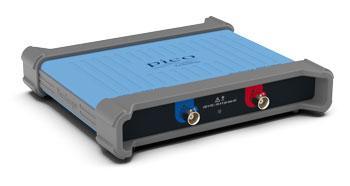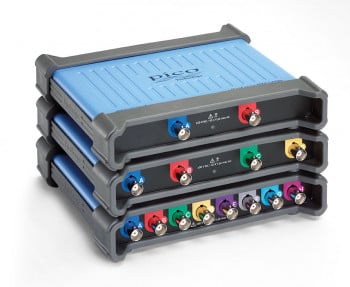Crystal-clear waveform analysis
The PicoScope 4000A Series of PC oscilloscopes is a second-generation upgrade and expansion of our high-resolution, deep-memory product portfolio.
With 2-, 4- and 8-channel models available, the PicoScope 4000A Series boasts 12-bit hardware resolution (to 16 bits with Resolution Enhancement), 256 MS deep capture memory, 20 MHz bandwidth with 80 MS/s sampling speed, up to 70 dB SFDR and a built-in 14-bit triggerable signal generator and 80 MS/s AWG. A SuperSpeed USB 3.0 interface powers the instrument and delivers up to 160 MS/s communications to the host PC.
All models run with the popular PicoScope 6 user interface and benefit from the free PicoSDK software development kit, which gives users direct programming control of the hardware for custom applications. The scopes also work with PicoLog 6 data logging software for lower-speed long-duration captures.
The following features come as standard on all 4000A oscilloscopes:
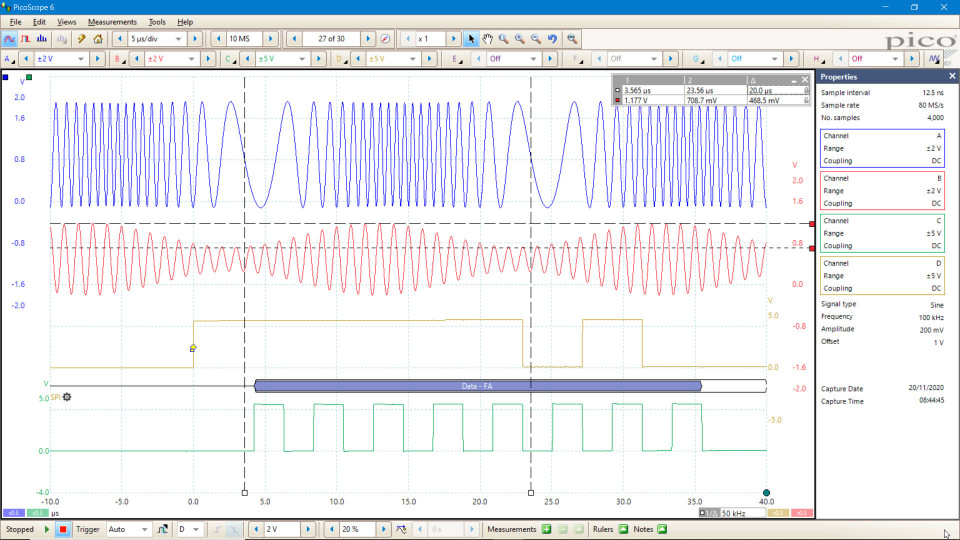
|
|
Up to 8 channels of high resolution
With the PicoScope 4000A Series providing a choice of either 2, 4 or 8 high-resolution analog channels you can easily view audio, ultrasonic, vibration and power waveforms, analyze timing of complex systems, and perform a wide range of precision measurement tasks on multiple inputs at the same time. The scopes have a small, compact footprint, yet the BNC connectors with a minimum 20 mm spacing still accept all common probes and accessories. Despite their compact size, there is no compromise on performance. With a high vertical resolution of 12 bits, 20 MHz bandwidth, 256 MS buffer memory, and a fast sampling rate of 80 MS/s, the PicoScope 4000A Series has the power and functionality to deliver accurate results. With up to 8 channels, these oscilloscopes can analyze multiple serial buses such as UART, I2C, SPI, CAN and LIN plus control and driver signals.
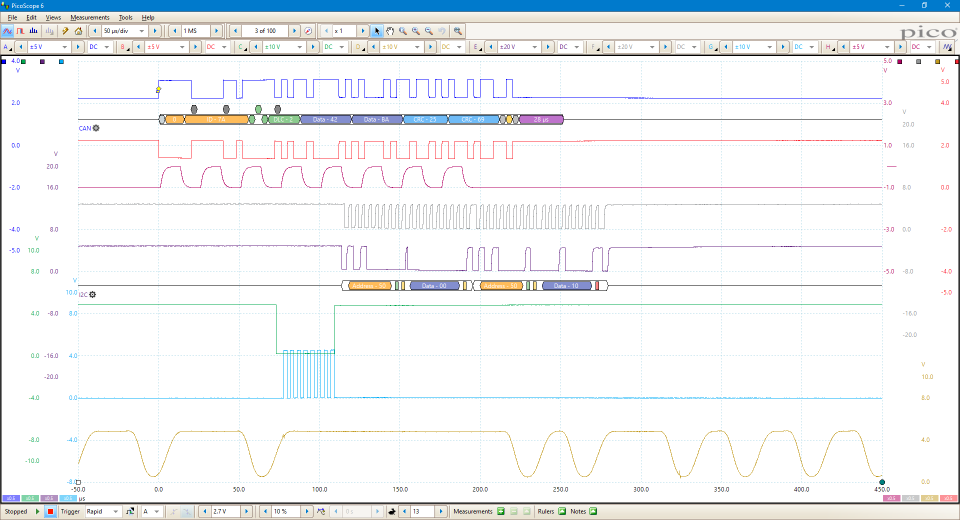
Why choose the PicoScope 4000A Series oscilloscopes?
The PicoScope 4000A Series provides 20 MHz bandwidth, low noise, 12-bit resolution, deep capture memory and an integrated function and arbitrary waveform generator in a compact USB 3 connected PC-based package, together with a proven user interface. This series of oscilloscopes is especially suited to engineers, scientists and technicians working on a wide range of electrical, mechanical, audio, lidar, radar, ultrasonic, NDT and predictive maintenance systems who need to make precise measurements and analysis of repetitive or single-shot long-duration waveforms.
The PicoScope 4000A Series is unlike conventional oscilloscopes with 8-bit resolution and limited capture memory or card-based digitizers that require an expensive mainframe and offers the following benefits:
- PicoScope 6 user interface with time- and frequency-domain waveform views
- Automatic measurements of important waveform parameters on up to a million waveform cycles with each triggered acquisition using DeepMeasure™
- Decoding of 18 popular industry serial bus standards
- An application programming interface that provides direct control of the hardware
- Five-year warranty included as standard
Suitable for a broad range of applications, including:
- Power supply start sequencing
- 7-channel audio systems
- Multi-sensor systems
- Multi-phase drives and controls
- Predictive/preventive maintenance
- Complex embedded system development
- Power harmonics analysis
- Vibration analysis and diagnostics
- Long-duration waveform capture
- Lubricant analysis
- Acoustic emission analysis
- Oil condition sensors
- Machine monitoring
- Motor condition monitoring overview and motor current signature analysis (MCSA)
- Model-based voltage and current systems
- Infrared thermography
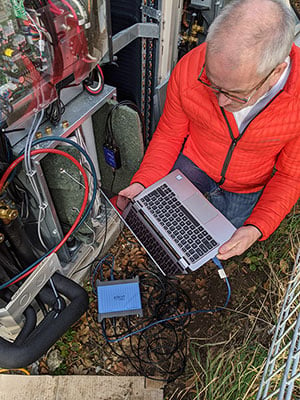
Complex embedded systems
When debugging an embedded system with a scope, you can quickly run out of channels. You may need to look at an I2C or SPI bus at the same time as multiple power rails, DAC outputs and logic signals. With up to eight channels, the PicoScope 4000A Series can cope with all of this. Choose whether to decode up to eight serial buses, with analog waveforms and decoded data both visible, or a combination of serial buses and other analog or digital signals. PicoScope provides advanced triggering on all channels, so you can search for runt pulses, dropouts and noise as well as looking for data patterns using the 4-input Boolean logic trigger.
Pack contents
-
PicoScope 4000A Series 2-, 4- or 8-channel oscilloscope
-
Oscilloscope probes (if purchased)
-
USB 3.0 cable 1.8 m
-
Quick Start Guide
| Model | PicoScope 4224A | PicoScope 4424A | PicoScope 4824A |
|---|
| Oscilloscope – vertical | |||
|---|---|---|---|
| Input channels | 2 | 4 | 8 |
| Bandwidth (−3 dB) | 20 MHz (50 mV to 50 V ranges) 10 MHz (10 mV and 20 mV ranges) |
||
| Rise time (calculated) | 17.5 ns (50 mV to 50 V ranges) 35.0 ns (10 mV and 20 mV ranges) |
||
| Input type | BNC, at least 20 mm spacing | ||
| Vertical resolution | 12 bits | ||
| Software-enhanced vertical resolution | Up to 16 bits | ||
| Input sensitivity | 2 mV/div to 10 V/div (10 vertical divisions) | ||
| Input ranges | ±10 mV to ±50 V full scale, in 12 ranges | ||
| Input coupling | Software-selectable AC / DC | ||
| Input characteristics | 1 MΩ ∥ 19 pF | ||
| DC accuracy | ±1% of full scale ±300 μV | ||
| Analog offset range (vertical position adjustment) | ±250 mV (10 mV to 500 mV ranges) ±2.5 V (1 V to 5 V ranges) ±25 V (10 V to 50 V ranges) |
||
| Analog offset accuracy | ±1% of offset setting additional to basic DC accuracy | ||
| Maximum input voltage | ±50 V DC, 42.4 V peak AC | ||
| Overvoltage protection | ±100 V (DC + AC peak) | ||
| Oscilloscope – horizontal | |
|---|---|
| Maximum sampling rate (real-time) | 80 MS/s (up to four channels in use) 40 MS/s (five or more channels in use) |
| Maximum sampling rate (USB 3.0, continuous streaming mode) | 20 MS/s using PicoScope 6 software, shared between channels 80 MS/s max. for a single channel using PicoSDK. 160 MS/s total across all channels. (PC-dependent) |
| Timebase ranges | 20 ns/div to 5000 s/div |
| Buffer memory | 256 MS shared between active channels |
| Streaming buffer memory (PicoScope) | 100 MS |
| Streaming buffer memory (SDK) | Up to available PC memory |
| Maximum buffer segments | 10,000 |
| Maximum waveforms per second | 100,000 (PC-dependent) |
| Timebase accuracy | ±20 ppm (+5 ppm/year) |
| Sample jitter | 25 ps RMS typical |
| Dynamic performance (typical) | |
|---|---|
| Crosstalk | −76 dB, DC to 20 MHz |
| Harmonic distortion | < −60 dB, 10 mV range < −70 dB, 20 mV and higher ranges |
| SFDR | > 60 dB, 20 mV and 10 mV ranges > 70 dB, 50 mV and higher ranges |
| Noise | 45 μV RMS on 10 mV range |
| Bandwidth flatness | DC to full bandwidth (+0.2 dB, −3 dB) |
| Pulse response | < 1% overshoot |
| Triggering | |||
|---|---|---|---|
| Source | Channels A to B | Channels A to D | Channels A to H |
| Trigger modes | Free run, auto, repeat, single, rapid (segmented memory) | ||
| Trigger types | Edge with adjustable hysteresis, pulse width, window, window pulse width, dropout, window dropout, interval, logic level, runt pulse | ||
| Trigger sensitivity | Digital triggering provides 1 LSB accuracy up to full bandwidth | ||
| Maximum pre-trigger capture | 100% of capture size | ||
| Maximum post-trigger delay | Zero to 4 billion samples (settable in 1 sample steps) | ||
| Trigger rearm time | < 3 μs on fastest timebase | ||
| Maximum trigger rate | Up to 10 000 waveforms in a 30 ms burst | ||
| Advanced digital trigger levels | All trigger levels, window levels and hysteresis values settable with 1 LSB resolution across input range | ||
| Advanced digital time intervals | Settable with 1 sample resolution from 1 sample (minimum 12.5 ns) up to 4 billion sample intervals | ||
| Function generator | |
|---|---|
| Standard output signals | Sine, square, triangle, DC voltage, ramp, sinc, Gaussian, half-sine, white noise, PRBS |
| Standard signal frequency | 0.03 Hz to 1 MHz |
| Sweep modes | Up, down, dual |
| Triggering | Can trigger a counted number of waveform cycles or sweeps (up to 1 billion) from the scope trigger or manually from software. |
| Frequency accuracy | ±20 ppm |
| Frequency resolution | < 0.02 Hz |
| Voltage range | ±2 V |
| Amplitude and offset adjustment | Signal amplitude and offset within ± 2V range. Adjustable in approx 300 μV steps. |
| Amplitude flatness | < 0.5 dB to 1 MHz typical |
| DC accuracy | ±1% of full scale |
| SFDR | 87 dB typical |
| Output characteristics | Rear-panel BNC, 600 Ω output impedance |
| Overvoltage protection | ±10 V |
| Arbitrary waveform generator | |
|---|---|
| Update rate | 80 MS/s |
| Buffer size | 16 kS |
| Resolution | 14 bits (output step size approximately 300 μV) |
| Bandwidth | 1 MHz |
| Rise time (10% to 90%) | 150 ns |
| Sweep modes, triggering, frequency accuracy and resolution, voltage range and accuracy and output characteristics as for function generator. | |
| Spectrum analyzer | ||||||
|---|---|---|---|---|---|---|
| Frequency range | DC to 20 MHz | |||||
| Display modes | Magnitude, average, peak hold | |||||
| Windowing functions | Rectangular, Gaussian, triangular, Blackman, Blackman-Harris, Hamming, Hann, flat-top | |||||
| Number of FFT points | Selectable from 128 up to 1 million in powers of 2 | |||||
| Scale / units | X axis : linear or log 10 Y axis : logarithmic (dbV, dBu, dBm, arbitrary) or linear (volts) |
|||||
| Math channels | |
|---|---|
| General functions | −x, x+y, x−y, x*y, x/y, x^y, sqrt, exp, ln, log, abs, norm, sign, sin, cos, tan, arcsin, arccos, arctan, sinh, cosh, tanh, derivative, integral, delay |
| Filter functions | Lowpass, highpass, bandstop, bandpass |
| Graphing functions | Frequency, duty cycle |
| Multi-waveform functions | Min, max, average, peak |
| Operands | Input channels, reference waveforms, time, constants, pi |
| Automatic measurements | |
|---|---|
| Scope mode | AC RMS, true RMS, cycle time, DC average, duty cycle, falling rate, fall time, frequency, high pulse width, low pulse width, maximum, minimum, peak to peak, rise time, rising rate. |
| Spectrum mode | Frequency at peak, amplitude at peak, average amplitude at peak, total power, THD %, THD dB, THD+N, SFDR, SINAD, SNR, IMD |
| Statistics | Minimum, maximum, average and standard deviation |
| DeepMeasure™ | |
|---|---|
| Scope mode | AC RMS, true RMS, cycle time, DC average, duty cycle, falling rate, fall time, frequency, high pulse width, low pulse width, maximum, minimum, peak to peak, rise time, rising rate. |
| Spectrum mode | Frequency at peak, amplitude at peak, average amplitude at peak, total power, THD %, THD dB, THD+N, SFDR, SINAD, SNR, IMD |
| Statistics | Minimum, maximum, average and standard deviation |
| Serial decoding | |||||
|---|---|---|---|---|---|
| Protocols | 1-Wire, ARINC 429, CAN, CAN FD, DALI, DCC, DMX512, Ethernet (10Base-T), FlexRay, I²C, I²S, LIN, Manchester, MODBUS (ASCII and RTU), PS/2, SENT, SPI, UART/RS-232. Subject to number of channels available. | ||||
| Inputs | All input channels with any mixture of protocols | ||||
| Mask limit testing | |
|---|---|
| Mask creation | User-drawn, table entry, auto-generated from waveform or imported from file |
| Actions | Highlight on screen, select in buffer overview, activate alarm |
| Statistics | Pass/fail, failure count, total count |
| Alarms | |
|---|---|
| Initiating events | Capture, buffer full, mask fail |
| Alarm actions | Beep, play sound, stop/restart capture, run executable, save current buffer/all buffers, trigger signal generator |
| Display | |||||
|---|---|---|---|---|---|
| Interpolation | Linear or sin(x)/x | ||||
| Persistence modes | Digital color, analog intensity, fast, custom | ||||
| Data export | |
|---|---|
| Output file formats | BMP, CSV, GIF, JPG, MATLAB 4, PDF, PNG, PicoScope data, PicoScope settings, TXT |
| Output functions | Copy to clipboard, print |
| Environmental | ||
|---|---|---|
| Temperature range (operating) | 0 °C to 45 °C | |
| Temperature range (stated accuracy) | 20 °C to 30 °C | |
| Temperature range (storage) | –20 °C to +60 °C | |
| Humidity range (operating) | 5% to 80% RH non-condensing | |
| Humidity range (storage) | 5% to 95% RH non-condensing | |
| Altitude | Up to 2000 m | |
| Pollution degree | EN 61010 pollution degree 2: “only nonconductive pollution occurs except that occasionally a temporary conductivity caused by condensation is expected” | |
| Physical properties | |
|---|---|
| Dimensions | 190 x 170 x 40 mm (7.5″ x 6.7″ x 1.6″) |
| Weight | < 0.55 kg (19.4 oz) |
| Software | ||
|---|---|---|
| Windows software | PicoScope 6 PicoLog 6 PicoSDK software development kit Windows 7, 8 or 10 recommended (read more) |
|
| macOS software | PicoScope 6 Beta (feature list) PicoLog 6 Software development kit (SDK) OS versions: see release notes |
|
| Linux software | PicoScope 6 Beta (feature list) Software development kit (SDK) See Linux Software & Drivers for details of supported distributions |
|
| Raspberry Pi software | PicoLog 6 for Raspberry Pi 3B and 4B (Raspberry Pi OS) | |
| Languages | PicoScope 6: English, Chinese (simplified), Chinese (traditional), Czech, Danish, Dutch, Finnish, French, German, Greek, Hungarian, Italian, Japanese, Korean, Norwegian, Polish, Portuguese, Romanian, Russian, Spanish, Swedish, Turkish PicoLog 6: English (UK), English (US), Simplified Chinese, Dutch, French, German, Italian, Japanese, Korean, Russian, Spanish |
|
| General | ||||||
|---|---|---|---|---|---|---|
| What’s in the box? | PicoScope 4000A Series high-resolution oscilloscope USB 3.0 cable USB Oscilloscope Quick Start Guide 10:1/1:1 switched probes (quantity shown below) |
|||||
| Number of probes included | 2 | 4 | 4 | |||
| PC connectivity | SuperSpeed USB 3.0 (USB 2.0 compatible) | |||||
| Power requirements | Powered from USB | |||||
| Ground terminal | M4 screw on rear panel | |||||
| Safety compliance | Designed to EN 61010-1; LVD compliant | |||||
| EMC compliance | Tested to meet EN61326-1 and FCC Part 15 Subpart B | |||||
| Environmental compliance | RoHS and WEEE | |||||
| Total satisfaction guarantee | In the event that this product does not fully meet your requirements you can return it for an exchange or refund. To claim, the product must be returned in good condition within 14 days. | |||||
| Warranty | 5 years | |||||

